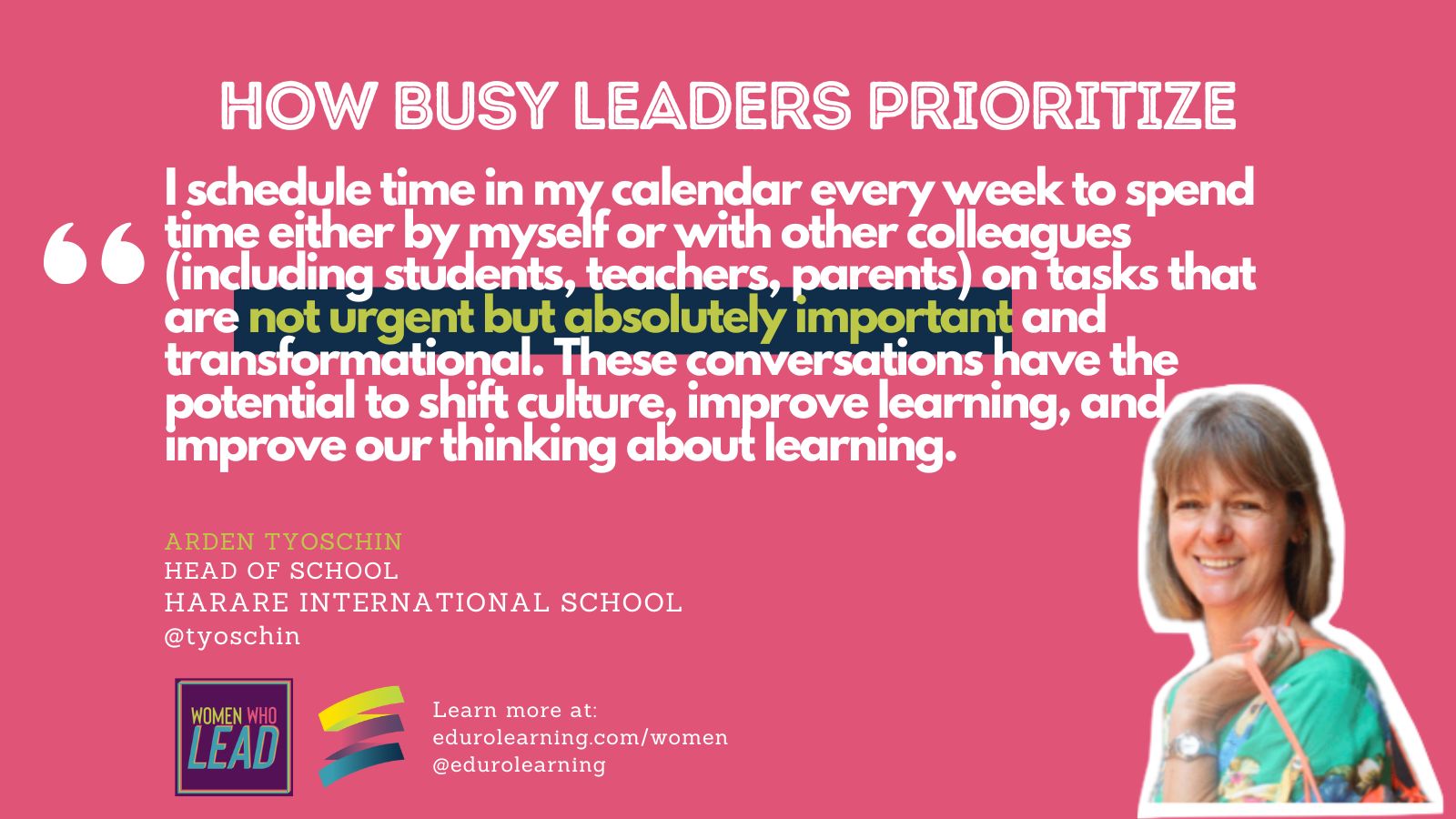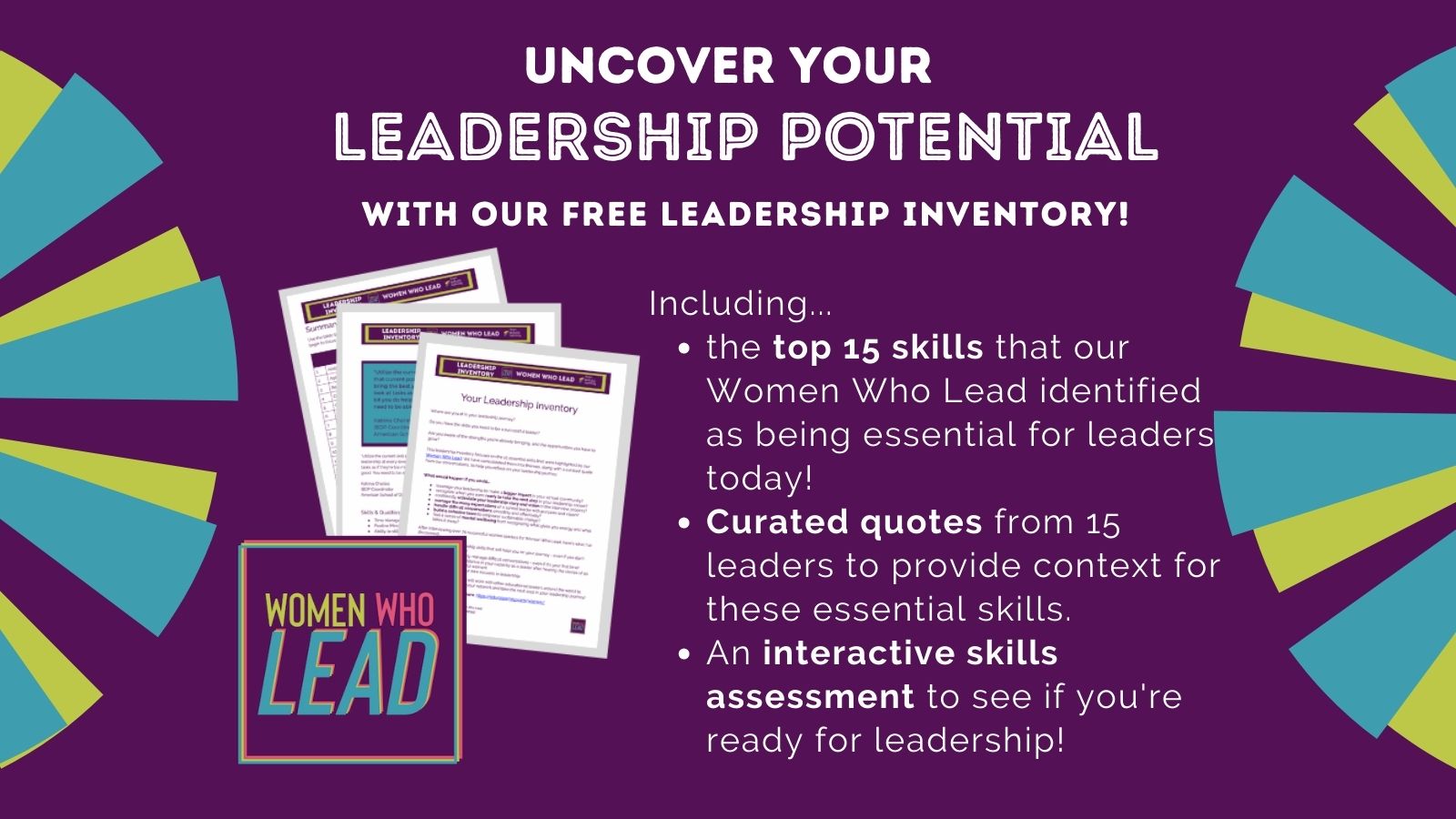
We all know how demanding a leadership role can be. Not only are we constantly trying to make progress on our own goals for ourselves and for our organization, but we also have to simultaneously keep in mind the varying needs of the whole community of stakeholders. Balancing those competing priorities can quickly become overwhelming, especially if you don’t have a strategy or system to deal with them.
In the Women Who Lead interviews, I asked our more than 70 successful women how they deal with the many demands of their roles, and what strategies they have developed that work for them. In today’s article I’ll share strategies that help leaders manage their own daily tasks and interactions, and in the next article, I’ll address how to manage the needs of a school or division.
Separate the Big Picture vs the Day-to-Day
Many of our Women Who Lead talked about being realistic in terms of managing both large and small scale projects. Carla Marschall, Director of Teaching and Learning at UWC SEA in Singapore, notes that “it’s really important when you’re in a leadership position not to have a knee-jerk reaction and get distracted by the ‘daily fires’.” Of course there’s short term stuff that you need to take care of right away, which is just as important as strategic work, but you need to make sure to take incremental steps towards the larger goal on a daily basis as well. Carla reminds us that “micro events lead up to the big strategic stuff – unless you keep moving forward on that, it will never happen. Find a mechanism to think at the level of the balcony and level of the dance floor.’
Arden Tyoshin, Head of School at Harare International School in Zimbabwe, also points out the importance of making time for big-picture tasks. Referring to leading through the COVID crisis, Arden says the one lesson that she’s taken away from the last 18 months is to create time in her schedule for the not-urgent, but important. These are blocked times, either by herself or with others, that have the potential to result in transformational work, to shift culture, improve learning, and improve thinking about learning. On the HIS leadership team, they’re seeing an increased impact because they’re focusing on making time for the important but not urgent.
Abeer Shinnawi, Founder of Altair Consulting, points out that “You’re the one who has the control over what you can accomplish.” She recognizes that you don’t need to accomplish everything all at once, but you can chip away at tasks based on needs, time, physical or mental energy. Importantly she has learned not to ruminate over what she could or should have done, that “you can’t go back and reverse the past – you have to learn from it and apply it to your next project.”
Recognize What’s In Your Control
Determining what she can control, and what’s out of her hands, has helped Beth Dressler, Deputy Head of School and PYP Principal at Dresden International School in Germany, free up some “brain space” for other things. She intentionally lets go of things that are out of her control so they no longer take mental energy. She says, “sometimes the decision is made for you. I have a box in my brain and I just shut the box.”
Uncover YOUR Leadership Potentential
Uncover your leadership potential with our new FREE leadership inventory.
This interactive resource highlights the 15 essential skills for emerging leaders that our Women Who Lead referenced in the interviews.
You’ll get a consolidated look at the leadership skills that are essential for leaders today – and the opportunity to reflect on how you’re doing, including your unique strengths and where you have room to grow!
Access the Leadership Inventory here!
Know Yourself & Schedule Accordingly
Knowing yourself, how you operate and what you need to be productive was another key highlight in the Women Who Lead interviews. Carlene Hamley, Director of School Development at ISS in Shekou, China, knows that she needs time to process things, so she builds that time into her schedule. Knowing who you are and what you need to get the job done means you can operate most efficiently in any situation.
Carlene also points out how important it is to pay attention to your own body and recognize how you’re feeling. If you’re tired, stressed and tense all the time, this may be a sign you need to “pause” and come back to a task or project. “It doesn’t mean you failed, it just means you’re re-calibrating. You can take a step away and re-energize, which will give you much more renewed energy to what you want to achieve. It’s all about knowing who you are, how you react to things and paying attention to that.”
Firoozeh Dumas, NYTimes Bestselling Author, talks about how she manages her day to be most productive. She (seriously) jokes that she’s “smarter in the morning” so she wakes up early and uses her quiet morning time to meditate, plan her day, and recognize how the small steps she takes each day build up to the larger project. Although every day of her life is different, her number one priority is her child and her family. She says: “all the relationships in our life are like a garden, you have to tend to them.” Over time, she also learned that she needs to be kind to herself too. Every day she has a to-do list, which is all about taking care of others, and “sometimes I just forget that I need to just be nice to myself.” She’s learned to make this more of a priority as she’s gotten older.
Charlotte Diller, Director of Technology at ISKL, Malaysia, knows that she works best in the morning, so at the end of the day before, she writes down the 3-5 things she needs to focus on the next day, and starts her day with those. When she has control over timing, she sets her meetings for the afternoons so she can be productive in the morning. When she recognizes that there are others on her team who may do certain tasks better, those are delegated. She understands that she doesn’t need to do everything herself, but she does need to support others.
Be Strategic
Katrina Charles, IB Diploma Coordinator at the American School of Doha, believes that in order to make decisions you have to have a strategic plan. Katrina says she likes to have a “live strategic plan that she can tweak weekly.” She plans out her weeks with specific days for specific tasks, like days where meetings are a priority, and other days where admin tasks are a priority. Because disorganization makes being an effective leader so hard, she notes that you can not underestimate the need for organization.
Being strategic also includes working well with the people on your team. Head of Washington International School, Suzanna Jemsby, recommends setting clear expectations with your admin so that you have the time you need to be effective and efficient. As Suzanna walks to school she sets calls and meetings, and she has a specific day of the week that’s blocked out for thinking. Her recommendation is to “hire phenomenal people, become good at delegating, and you do less and less.” To help you become more efficient in your work, she says you need to figure out what it costs to run a meeting by looking at the salaries of all the people involved. If you have to have that meeting, make sure it’s a $6000 meeting (if that’s what it costs). Recognizing how much a meeting “costs” could help you think about time in general.
Create a ‘To Be’ list, Not a ‘To Do’ List
Angela Meiers, Founder of You Matter, highlights an important mindshift that all leaders should make. Most of us follow the default mentality of “if I have this, if I do this, then I’m going to be…” She notes that the problem is that you can follow all of that and still not be what you expect.
The option she recommends is thinking about “Who am I seeking to be? Why does my business exist? Who do I want to be for myself, my clients, my community?” When you are very clear on that you can look at your to-do list, and if it’s not in service of your to-be list, your congruence is going to be off. “If you know who you want to be and you take actions every day to be that, I believe you will have an abundance of clarity, happiness and impact.”
She says leadership is a risk. It’s a constant state of self awareness and reflection. “You can feel it in every bone in your body when you’re not living your best life, not serving in the way that only you can serve. It’s the balance of those two.”
Finding Your Personal Process
This article has shared some prioritizing tips and approaches that came up during the Women Who Lead interviews (https://edurolearning.com/women/), but keep in mind that every leader’s situation is different, and you shouldn’t feel like you need to start adopting all of these ideas right away in order to make progress. Gathering these and other similar examples for inspiration, and testing out different methods, can help you recognize what might work for you – but ultimately, you will find yourself creating your own system for staying focused and productive.
If you are looking for more real-life practical stories, examples and strategies like this, that uncover the realities of being a woman in leadership in education, you will love Women Who Lead. Designed to share the “behind the scenes” stories of over 70 successful women in leadership, this online course will help you find your leadership potential – and learn how to make it a reality. Our next global cohort begins in July, registration opens in May. Find out more here: https://edurolearning.com/women/.
Join the Cohort!
Hear more from our successful women leaders and learn the exact strategies they use to find a space of wellbeing! Learn from the stories of over 70 successful women leaders and build your professional learning network inside Women Who Lead!
Find out more at: https://edurolearning.com/women/.



0 responses on "How Busy Leaders Prioritize and Find Focus"